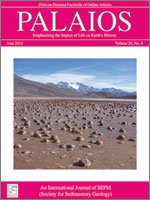Changes in the stratigraphic distribution of manganese (Mn)-bearing columnar structures interpreted as rhizocretions indicate a shift in paleohydrological conditions in the Bighorn Basin during the Paleocene–Eocene Thermal Maximum (PETM). While most studies agree that significant warming occurred during the PETM, interpretations differ as to the effects of warming on the paleohydrologic regime. The columns consist of sand and silt cemented by calcite that also contains black, Mn-bearing nodules. The rhizocretions are typically vertically oriented and range from a few cm to over 50 cm in diameter and up to 75 cm tall. They are interpreted to have formed in the rhizospheres of relatively large root systems. The rhizocretions are restricted to intervals, showing only weak paleopedogenic development, that are interpreted as crevasse-splay or avulsion deposits. While such deposits are present throughout the study section at Polecat Bench in the northern Bighorn Basin, Wyoming, the Mn-bearing rhizocretions are found only below and above the PETM interval and within the initial carbon isotope excursion (CIE) marking the onset of the PETM. The abundance of black, Mn-rich nodules (< 1 cm in diameter) in the rhizocretions and presence of other pedogenic features indicate that the soils in which the plants were growing underwent seasonal flooding and repeated redox alternations. Their distribution in similar host deposits throughout the study interval, except for the main body of the PETM, supports climate as the driving factor in preservation of the Mn-bearing rhizocretions. The Mn-bearing rhizocretions support recent studies that suggest transient drying in northern Wyoming during the PETM.
How to translate text using browser tools
1 June 2014
MANGANESE-BEARING RHIZOCRETIONS IN THE WILLWOOD FORMATION, WYOMING, U.S.A.: IMPLICATIONS FOR PALEOCLIMATE DURING THE PALEOCENE–EOCENE THERMAL MAXIMUM
DANIEL T. WOODY,
JON J. SMITH,
MARY J. KRAUS,
STEPHEN T. HASIOTIS
ACCESS THE FULL ARTICLE
It is not available for individual sale.
This article is only available to subscribers.
It is not available for individual sale.
It is not available for individual sale.

PALAIOS
Vol. 29 • No. 6
June 2014
Vol. 29 • No. 6
June 2014




